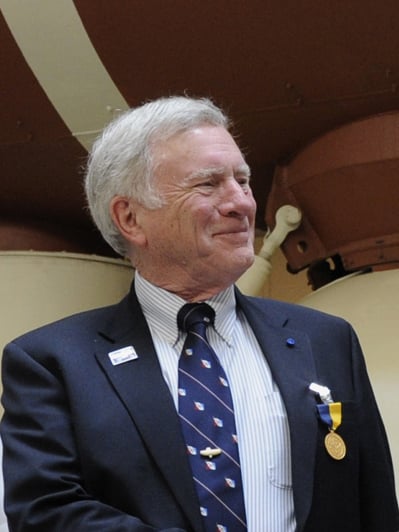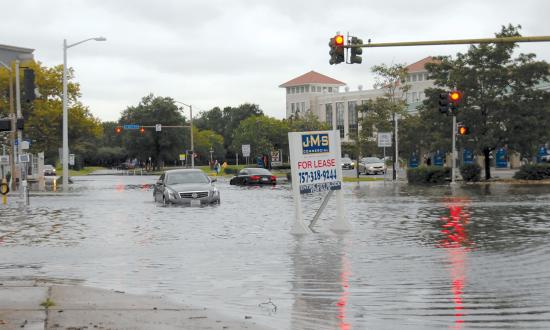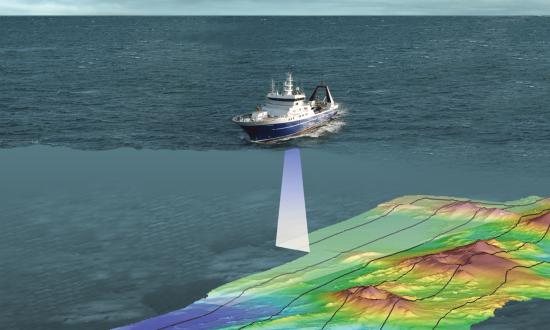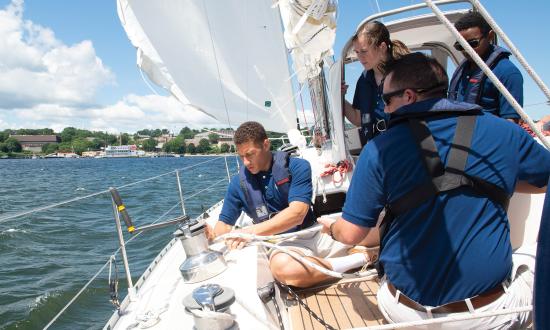Approximately 71 percent of the Earth’s surface is seafloor, so it is not surprising that more than 80 percent of the planet’s known volcanoes are found there. At an average depth of 8,500 feet, they and associated processes produce more than 75 percent of the world’s magmatic flow.
A current estimate suggests that there are more than one million submarine volcanoes. Most are extinct; many have become deeply submerged seamounts. Only 5–10 percent of the World Ocean has been explored. Current international programs to systematically map the global seafloor at hydrographic quality soon will lead to the discovery of many more of these features.
Seafloor volcanism is primarily created by movements of the Earth’s lithospheric plates. Along zones where the plates diverge, new magma rises to the seafloor, marking the largest continuous volcanic mountain range on earth—the mid-ocean ridge, found in all major ocean basins. Mostly submerged, this divergent plate margin surfaces in Iceland, and spreading rates along the global feature range from less than .4 inches per year to as much as 6.3 inches per year.
The opposite dynamic operates along convergent plate margins where one plate plunges beneath another, creating the deepest ocean trenches and a parallel, often land-based volcanic arc such as Japan, the Aleutian Islands, or the Andes. Circling most of the Pacific, this zone is known as the Ring of Fire and is a source of the planet’s largest earthquakes and many destructive tsunamis.
A third source of submarine volcanism is generated by what are known as hot spots, created by “aneurysms” in an oceanic plate. As a plate migrates over a deep mantle source of molten rock, the magma pushes up through the weakened plate. The magma source is usually fixed deep below the plate, which moves past it creating island, or seamount, chains.
The Hawaii-Emperor seamount chain is a good example of this process. Its highest mountains and youngest volcanoes are on the Big Island of Hawaii. The process has been active for nearly 165 million years, and the chain stretches to the Aleutian Arc off Alaska. The oldest islands are below the sea surface, reduced by weathering and plate submergence to seamounts. Directly above the current location of the Hawaii mantle hot spot, a new island is growing 3,100 feet below sea level. Known as Lōʻihi (“long one”), it should break the surface in about 100,000 years.
A much more modest young volcano is Axial Seamount, 300 miles off the Oregon coast at a depth of 4,600 feet. It covers an area of 12 by 18 miles and has a height of 3,600 feet. It has erupted three times in the past 20 years, most recently in 2015. It is forming at the intersection of a small hot spot chain and the Juan de Fuca Ridge spreading center.
At present, the world’s largest volcano is the extinct Tamu Massif in the Pacific Ocean, 1,000 miles east of Japan. With an area about the size of New Mexico, it rises 14,600 feet from the seafloor, although the summit is at a depth of 6,500 feet.
For eruptions that occur in shallow waters less than 1,000 feet deep, there often are surface indications such as clouds of gases and floating pumice (a buoyant form of lava). In extreme cases. these indications can mean the imminent creation of new islands as the volcanoes push up through the sea surface. Perhaps the best known and documented is the island of Surtsey created in 1963 off Iceland. Often such islands are short-lived as they are initially composed of volcanic ash that is soon weathered away by wave action. This was not the case with Surtsey, where the ash was replaced with lava flows. Today, it is a 346-acre, 510-foot-high island slowly being repopulated by nature.
A more speculative phenomenon is the possible loss of vessels passing through the zone of gas-foamed water during a subsurface volcanic eruption. This is because the bubble-rich water is less dense than surrounding seawater to the point that a vessel has less buoyancy and could sink. That is the theory, and laboratory experiments have demonstrated this is possible. Anecdotal accounts have reported that at least three vessels have sunk with the loss of all hands while in such areas. Was submarine volcanism responsible? Or something else? The small community of Bermuda Triangle believers and their alien friends love this!







